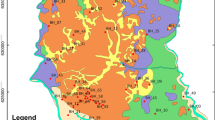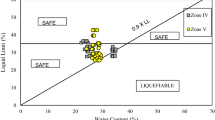Abstract
An effort has been made to perform a detailed characterization of fine-grained soils considering the relative significance of plasticity index for liquefaction risk assessment of the alluvial soil along Indo-Gangetic River banks. To establish this, the author emphasizes the application of computational models in comparison to statistical or empirical approaches for investigation. The novel approach for evaluating the liquefaction risk of fine-grained deposits is performed using different computational models which were satisfactorily validated in the present study. These models consider SPT N-value and peak ground acceleration due to earthquakes along with the consideration of basic geotechnical properties of fine-grained soil. The comparative study suggests that the artificial neural network (ANN) model has achieved the best predictive accuracy as compared to the other four models and it can be used to facilitate the liquefaction risk assessment of fine-grained soil deposits. In addition, liquefaction hazard mapping for the concerned study area is presented based on the ANN model. The artificial intelligence (AI)-based liquefaction mapping technique has high potential as it radically advances risk prediction and preparedness against such seismic events. Also, the influence of some of the significant input parameters on liquefaction susceptibility has been elaborately discussed, in terms of the correlation matrix and relative significance plots. Liquid limit and plasticity index have achieved a relative weightage of 14% and 16%, respectively, for predicting factor of safety (FL), whereas the SPT N-value has the highest impact of 21%. It is also observed that when the magnitude of the earthquake (Mw) is increased substantially from 6 to 7, a severe reduction in FL of 27.04% was noted, whereas for increment in Mw from 7 to 8, 30.5% average reduction in FL was observed. The finding of this study makes a substantial contribution in the field of liquefaction studies using AI models for fine-grained soil with medium to high plasticity.















Similar content being viewed by others
Data availability
Some or all data, models, or code that support the findings of this study are available from the corresponding author upon reasonable request.
References
Adnan RM, Liang Z, Parmar KS, Soni K, Kisi O (2021) Modeling monthly streamflow in mountainous basin by MARS, GMDH-NN and DENFIS using hydroclimatic data. Neural Comput Appl 33(7):2853–2871. https://doi.org/10.1007/s00521-020-05164-3 (Springer London)
Babu GLS, Singh VP (2010) Reliability analyses of a prototype soil nail wall using regression models. Geomech Eng 2(2):71–88. https://doi.org/10.12989/gae.2010.2.2.071
Bardhan A, Samui P, Ghosh K, Gandomi AH, Bhattacharyya S (2021) ELM-based adaptive neuro swarm intelligence techniques for predicting the California bearing ratio of soils in soaked conditions. Appl Soft Comput 110:107595 (Elsevier)
Bardhan A, Biswas R, Kardani N, Iqbal M, Samui P, Singh MP, Asteris PG (2022a) A novel integrated approach of augmented grey wolf optimizer and ANN for estimating axial load carrying-capacity of concrete-filled steel tube columns. Constr Build Mater 337:127454. https://doi.org/10.1016/j.conbuildmat.2022.127454
Bardhan A, Kardani N, Alzoùbi AK, Roy B, Samui P, Gandomi AH (2022b) Novel integration of extreme learning machine and improved harris hawks optimization with particle swarm optimization-based mutation for predicting soil consolidation parameter. J Rock Mech Geotech Eng. https://doi.org/10.1016/j.jrmge.2021.12.018
Bartlett SF, Youd TL (1995) Empirical prediction of liquefaction-induced lateral spread. J of Geotechnical Eng 121(4):316–329
Bray JD, Sancio RB, Riemer M, Durgunoglu HT (2004) Liquefaction susceptibility criterion of fine grained soil. In Proc. 11th Int. Conf. on Soil Dynamics and Earthquake Engineering and 3rd Int. Conf. on Earthquake Geotechnical Engineering, 1:655–662. Stallion Press, Singapore
Breiman L (2001) Random forests. Mach Learn 45:5–32. https://doi.org/10.1201/9780429469275-8
Cetin KO, Der Kiureghian A, Seed RB (2002) Probabilistic models for the initiation of seismic soil liquefaction. Struct Saf 24(1):67–82 (Elsevier)
Cetin KO, Seed RB, Kayen RE, Moss RES, Bilge HT, Ilgac M, Chowdhury K (2018) SPT-based probabilistic and deterministic assessment of seismic soil liquefaction triggering hazard. Soil Dyn Earthq Eng 115:698–709 (Elsevier)
Das G, Burman A, Bardhan A, Kumar S, Choudhary SS, Samui P (2022) Risk estimation of soil slope stability problems. Arab J Geosci 15(2):1–16 (Springer)
Dhilipkumar B, Bardhan A, Samui P, Kumar S (2021) Predicting probability of liquefaction susceptibility based on a wide range of CPT data. Int J Geotech Earthq Eng 12(2):18–41 (IGI Global)
Ecemis N, Demirci HE, Karaman M (2015) Influence of consolidation properties on the cyclic re-liquefaction potential of sands. Bull Earthq Eng 13(6):1655–1673 (Springer)
Erzin Y, Ecemis N (2015) The use of neural networks for CPT-based liquefaction screening. Bull Eng Geol Environ 74(1):103–116 (Springer)
Erzin Y, Ecemis N (2017) The use of neural networks for the prediction of cone penetration resistance of silty sands. Neural Comput Appl 28(1):727–736 (Springer)
Friedman JH, Roosen CB (1995) An introduction to multivariate adaptive regression splines. Stat Methods Med Res 4(3):197–217. https://doi.org/10.1177/096228029500400303
Ghani S, Kumari S (2021a) Liquefaction susceptibility of high seismic region of Bihar considering fine content. Basics Comput Geophys, no. January: 105–120. https://doi.org/10.1016/b978-0-12-820513-6.00012-6
Ghani S, Kumari S (2021b) Liquefaction study of fine-grained soil using computational model. Innov Infrastruct Solut 6(58):1–17. https://doi.org/10.1007/s41062-020-00426-4
Ghani S, Kumari S (2021c) Effect of plasticity index on liquefaction behavior of silty clay. In Soil Dynamics, 119:289–298. Springer, Singapore. https://doi.org/10.1007/978-981-33-4001-5_26
Ghani S, Kumari S (2021d) Probabilistic study of liquefaction response of fine-grained soil using multi-linear regression model. J Inst Eng Ser A. Springer India, 1–21. https://doi.org/10.1007/s40030-021-00555-8
Ghani S, Kumari S (2022) Prediction of liquefaction using reliability-based regression analysis. In Advances in Geo-Science and Geo-Structures, 11–23. Springer
Ghani S, Kumari S, Ahmad S (2022) Prediction of the seismic effect on liquefaction behavior of fine-grained soils using artificial intelligence-based hybridized modeling. Arab J Sci Eng 47(4):5411–5441. https://doi.org/10.1007/s13369-022-06697-6
Goh ATC, Zhang W, Zhang Y, Xiao Y, Xiang Y (2018) Determination of Earth pressure balance tunnel-related maximum surface settlement: a multivariate adaptive regression splines approach. Bull Eng Geol Environ 77(2):489–500. https://doi.org/10.1007/s10064-016-0937-8 (Springer Berlin Heidelberg)
Gratchev IB, Sassa K, Fukuoka H (2006) How reliable is the plasticity index for estimating the liquefaction potential of clayey sands? J Geotech Geoenvironmental Eng 132(1):124–127. https://doi.org/10.1061/(asce)1090-0241(2006)132:1(124)
Guo T, Prakash S (1999) Liquefaction of silts and silt-clay mixtures. J Geotech Geoenvironmental Eng Ing 125(8):706–710
Huang GB, Zhu QY, Siew CK (2006) Extreme learning machine: theory and applications. Neurocomputing 70(1–3):489–501. https://doi.org/10.1016/j.neucom.2005.12.126
Ishihara K, Troncoso J, Kawase Y, Takahashi Y (1980) Cyclic strength characteristics of tailings materials. Soils Found 20(4):128–142
Jishnu RB, Naik SP, Patra NR, Malik JN (2013) Ground response analysis of Kanpur soil along Indo-Gangetic Plains. Soil Dyn Earthq Eng 51:47–57. https://doi.org/10.1016/j.soildyn.2013.04.001
Khan MA, Khan DMZ, Khan MB (2016) Effect of fines on liquefaction resistance in fine sand and silty sand. Int J Eng Res Appl 6(1):102–106
Kohestani VR, Hassanlourad M, Ardakani A (2015) Evaluation of liquefaction potential based on CPT data using random forest. Nat Hazards 79(2):1079–1089. https://doi.org/10.1007/s11069-015-1893-5 (Springer Netherlands)
Kurnaz TF, Kaya Y (2019) SPT-based liquefaction assessment with a novel ensemble model based on GMDH-type neural network. Arab J Geosci 12(15):1–14 (Springer)
Latha GM, Somwanshi A, Reddy KH (2013) A multiple regression equation for prediction of bearing capacity of geosynthetic reinforced sand beds. Indian Geotech J 43(4):331–343. https://doi.org/10.1007/s40098-013-0053-7
Liao SSC, Veneziano D, Whitman RV (1988) Regression models for evaluating liquefaction probability. J Geotech Eng 114(4):389–411. https://doi.org/10.1061/(ASCE)0733-9410(1988)114:4(389)
Marto A, Tan CS, Makhtar AM, Ung SW, Lim MY (2015) Effect of plasticity on liquefaction susceptibility of sand-fines mixtures. Appl Mech Mater 773–774:1407–1411. https://doi.org/10.4028/www.scientific.net/amm.773-774.1407
Naik SP, Patra NR, Malik JN (2012) Assessment of liquefaction potential of alluvial soil of Indo-Gangetic Interfluves, Northern India. In: GeoCongress 2012: State of the Art and Practice in Geotechnical Engineering, pp 1859–1868. https://doi.org/10.1061/9780784412121.191
Polito C (2001) Plasticity based liquefaction criteria. Int Conf Recent Advances Geotech Earthquake Eng and Soil Dyn. https://scholarsmine.mst.edu/icrageesd/04icrageesd/session01/25
Pradeep T, Bardhan A, Burman A, Samui P (2021) Rock strain prediction using deep neural network and hybrid models of ANFIS and meta-heuristic optimization algorithms. Infrastructures 6(9):1–20. https://doi.org/10.3390/infrastructures6090129
Pradeep T, Bardhan A, Samui P (2022) Prediction of rock strain using soft computing framework. Innov Infrastruct Solut 7(1):1–24. https://doi.org/10.1007/s41062-021-00631-9
Puri VK (1984) Liquefaction behavior and dynamic properties of loessial (silty) soils. University of Missouri-Rolla
Puri VK (1990) Liquefaction aspects of loessial soils. In: Proceeding 4th US National Conf on Earthquake Engineering, Earthquake Engineering Research Institute 3:755–762
Sandoval-Shannon JA (1989) Liquefaction and settlement characteristics of silt soils. University of Missouri-Rolla
Seed HB, Lee KL (1966) Liquefaction of saturated sands during cyclic loading. J Soil Mech Found Div 92(6):105–134
Seed HB, Idriss IM (1971) Simplified procedure for evaluating soil liquefaction potential. J Soil Mech Found Div 97(9):1249–1273 (American Society of Civil Engineers)
Thakur AS, Pandya S, Sachan A (2021) Dynamic behavior and characteristic failure response of low plasticity cohesive soil. Int J Civ Eng 19(2):167–185. https://doi.org/10.1007/s40999-020-00560-1 (Springer International Publishing)
Vucetic M, Dorby R (1988) Degradation of marine clays under cyclic loading. J Geotech Eng 114(2):133–149
Wang W (1979) Some findings in soil liquefaction. Earthquake Engineering Department, Water Conservancy and Hydroelectric Power Scientific Research Institute
Xue X, Liu E (2017) Seismic liquefaction potential assessed by neural networks. Environ Earth Sci 76(5):1–15 (Springer)
Yılmaz F, Öztürkoğlu Ş, Kamiloğlu HA (2022) A hybrid approach for computational determination of liquefaction potential of Erzurum City Center based on SPT data using response surface methodology. Arab J Geosci 15(1):1–19 (Springer)
Youd TL (1993) Liquefaction-Induced Lateral Spread Displacement. Naval Civil Engineering Lab Port Hueneme CA
Youd TL, Hansen CM, Bartlett SF (2002) Revised multilinear regression equations for prediction of lateral spread displacement. J Geotech Geoenvironmental Eng 128(12):1007–1017. https://doi.org/10.1061/(asce)1090-0241(2002)128:12(1007)
Zadeh LA (1988) Fuzzy logic. Computer 21(4):83–93. https://doi.org/10.1109/2.53
Zheng G, Zhang W, Zhou H, Yang P (2020) Multivariate adaptive regression splines model for prediction of the liquefaction-induced settlement of shallow foundations. Soil Dyn Earthq Eng 132(December 2019):106097. https://doi.org/10.1016/j.soildyn.2020.106097 (Elsevier Ltd)
Zhou J, Shi X, Du K, Qiu X, Li X, Mitri HS (2017) Feasibility of random-forest approach for prediction of ground settlements induced by the construction of a shield-driven tunnel. Int J Geomech 17(6):04016129. https://doi.org/10.1061/(asce)gm.1943-5622.0000817
Author information
Authors and Affiliations
Corresponding author
Ethics declarations
Ethics approval
Not applicable.
Consent to participate
Not applicable.
Consent for publication
The authors consent to the publication of this work.
Conflict of interest
The authors declare no competing interests.
Additional information
Responsible Editor: Zeynal Abiddin Erguler
Electronic supplementary material
Below is the link to the electronic supplementary material.
Appendix
Appendix
Steps to be followed for using the provided supplementary code:
-
a
Normalize the input parameters using Eq. (4). It may be noted that minimum and maximum values of the parameter are given in Table 1.
-
b
Paste the normalized data in an excel file named “Inputs” with sheet name “M” in the following sequence
-
1
(N1)60 values;
-
2
Liquid Limit (LL) values;
-
3
Plasticity Index (PI);
-
4
Fine Content (FC)
-
5
Peak Ground acceleration (PGA) and;
-
6
Cyclic Stress Ratio (Mw)
-
1
-
c
Run the.m file named “Liquefaction Assessment”
-
d
The results, i.e., FL, will be saved an excel file named “Factor of Safety”
Matlab Code:
clc;
clear;
close all;
data = xlsread('Inputs', 'M');
Inputs = data';
load('ANN_Model');
Predict = net(Inputs);
xlswrite('Factor of Safety', Predict)
Rights and permissions
About this article
Cite this article
Ghani, S., Kumari, S., Jaiswal, S. et al. Comparative and parametric study of AI-based models for risk assessment against soil liquefaction for high-intensity earthquakes. Arab J Geosci 15, 1262 (2022). https://doi.org/10.1007/s12517-022-10534-3
Received:
Accepted:
Published:
DOI: https://doi.org/10.1007/s12517-022-10534-3




